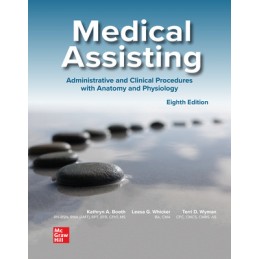- Obniżka


 Dostawa
Dostawa
Wybierz Paczkomat Inpost, Orlen Paczkę, DHL, DPD, Pocztę, email (dla ebooków). Kliknij po więcej
 Płatność
Płatność
Zapłać szybkim przelewem, kartą płatniczą lub za pobraniem. Kliknij po więcej szczegółów
 Zwroty
Zwroty
Jeżeli jesteś konsumentem możesz zwrócić towar w ciągu 14 dni*. Kliknij po więcej szczegółów
Opis
Unit One: Medical Assisting as a Career
1. Introduction to Medical Assisting
2. Healthcare and the Healthcare Team
3. Professionalism and Success
4. Interpersonal Communication
5. Legal and Ethical Issues
Unit Two: Safety and the Environment
6. Infection Control Fundamentals
7. Safety and Patient Reception
8. Office Equipment and Supplies
9. Examination and Treatment Areas
Unit Three: Communication
10. Written and Electronic Documents
11. Medical Records and Documentation
12. Electronic Health Records
13. Managing Medical Records
14. Telephone Techniques
15. Patient Education
Unit Four: Administrative Practices
16. Schedule Management
17. Insurance and Billing
18. Diagnostic Coding
19. Procedure Coding
20. Patient Collections and Financial Management
Unit Five: Applied Anatomy and Physiology
21. Organization of the Body
22. The Integumentary System
23. The Skeletal System
24. The Muscular System
25. The Cardiovascular System
26. The Blood
27. The Lymphatic and Immune Systems
28. The Respiratory System
29. The Nervous System
30. The Urinary System
31. The Reproductive Systems
32. The Digestive System
33. The Endocrine System
34. Special Senses
Unit Six: Clinical Practices
35. Infection Control Practices
36. Patient Interview and History
37. Vital Signs and Measurements
38. Assisting with a General Physical Examination
39. Assisting in Reproductive and Urinary Specialties
40. Assisting in Pediatrics
41. Assisting in Geriatrics
42. Assisting in Other Medical Specialties
43. Assisting with Eye and Ear Care
44. Assisting with Minor Surgery
Unit Seven: Assisting with Diagnostics
45. Orientation to the Lab
46. Microbiology and Disease
47. Collecting, Processing, and Testing Urine and Stool Specimens
48. Collecting, Processing, and Testing Blood Specimens
49. Electrocardiography and Pulmonary Function
50. Diagnostic Imaging
Unit Eight: Assisting in Therapeutics
51. Principles of Pharmacology
52. Dosage Calculation
53. Medication Administration
54. Physical Therapy and Rehabilitation
55. Nutrition and Health
Unit Nine: Medical Assisting Practice
56. Practice Management
57. Emergency Preparedness
58. Preparing for the World of Work
App 1 Diseases and Disorders
App 2 Prefixes, Suffixes, and Word Roots in Commonly Used Medical Terms
App 3 Abbreviations and Symbols Commonly Used in Medical Notations
